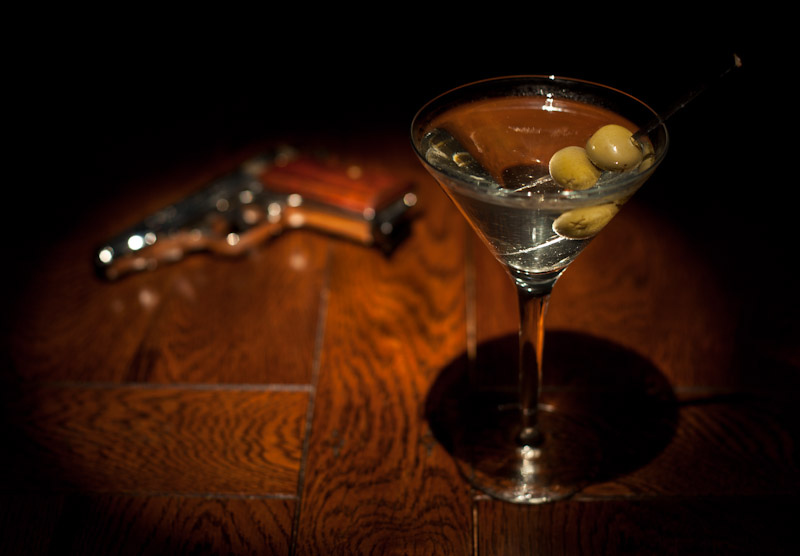Gin, War, and Special Ops

Gin has always been closely associated with war. Nicknamed “Dutch Courage” by English soldiers fighting the Catholic Counter-Reformation in the Netherlands, its martial connotation helped make it the commoner’s drink. With the addition of anti-malarial tonic water it becamethe symbol of global British Empire. Even Americans invoke this history when they pour one out today.
Oddly enough, though, in my memory it is associated with the “Rogue Warrior”: A U.S. special warfare operator named Richard Marcinko, who founded SEAL Team Six and went on to write a series of self-aggrandizing action novels during the 1990s that appealed to readers like impressionably adolescent me. Didactic and foul-mouthed, he would explain how to “clear” a room of terrorists while avoiding tunnel vision (breathe and swivel your head), which assault weapons are most reliable (H&K), and how to properly gain the tactical initiative (“fuck the fucking fuckers before they fuck you”). Whatever the value of his martial wisdom, his gin preferences were pure schlock: He was an evangelist for Bombay Sapphire, the spice-heavy monstrosity in a neon blue bottle, which International Distillers & Vintners released in 1987 to compete among “cool” college students who were then drinking Tanqueray. (You’ll recall which brand Snoop Dogg name-dropped in “Gin and Juice.”)
Bombay Sapphire is all gimmick. Its claim to fame is a recipe with ten different botanicals—the way a breakfast cereal bursts with ten exciting flavors. Images of each botanical are laser-engraved on the bottle bearing a label with a picture of Queen Victoria and a huge Sri Lankan sapphire that was once given by a famous silent movie star to a different famous silent movie star. (Yawn.) The recipe is supposedly “based on a recipe dating from 1761” (ten different weasel words!), but there’s no particular evidence that this is the case. The gin regularly underperforms in blind taste-tests and the bushy flavoring renders it useless in a martini, or really anything other than a gin & tonic. Disappointingly, the liquid isn’t even blue.
Of course, I fell for it wholesale and got a bottle when I was in college. Who wouldn’t be lured by the following romance?: “I was back in my room on the fourteenth floor of the Okura Hotel, nursing a $15 Bombay and soaking my tired old bones in the huge Japanese tub. My first night on the job had been a success: I’d planted six IEDs without any trouble.” If Marcinko didn’t mind clinging to an icy oil rig for nine hours, waiting for the right moment to surprise the “tangos” who’d taken the platform hostage, then why shouldn’t I stand by a gin that is needlessly painful to drink?
Only later did I realize my errors. With the cocktail culture boom of the 2000s came the American “Gin Renaissance” and the sudden profusion of brands like Plymouth, Hendrick’s, and Tanqueray 10. These gins are smoother than traditional London Dry gin in order to accommodate a nation of vodka drinkers, but they actually taste pretty darn good. And they can safely be mixed in a martini, which after all is the whole point of gin. What was Richard Marcinko thinking? I started to ask myself. Honestly, what is an action hero without a martini?
It turns out Marcinko is a limited guy, and not just in his choice of gin. He was a brilliant special ops pioneer, and Osama bin Laden would probably be alive today without him. But his obsession with breaking the rules of conventional war also extended to breaking all rules, which landed him in bureaucratic exile and—I later learned—federal prison for defrauding the government as a defense contractor. (What is it with these techno-thriller authors?) My solicitude for the maxims in his novels was probably as flawed as his belief in the mystique of a crappy ‘80s gin.
Bombay Sapphire, however, is still selling to suckers everywhere: The Burger King of gins, it maintains its market position by inertia despite having no obvious culinary justification for existence. It recently released a new spinoff, Bombay Sapphire East, whose claim to fame is two more botanical flavors—along with various oriental symbols and remembrances of British Indo-China on the bottle. Now owned by Bacardi, if that tells you anything about taste, Bombay Sapphire has also recently opened a massive distillery outside of London to supply the newly affluent in growing India and East Asia. The drink is clearly here to stay, but for my money don’t buy into the hype. Get a gin that tastes good, and if you really need something to remind you of gin’s martial heritage, grab a cheap plastic bottle of Gordon’s. It’s what James Bond used to drink during the war.
Barron YoungSmith is the former online editor of The New Republic. His work has appeared in Slate, Newsweek/The Daily Beast, and elsewhere. Follow him on Twitter at @byoungsmith.
Photo credit: Michael Nielsen

